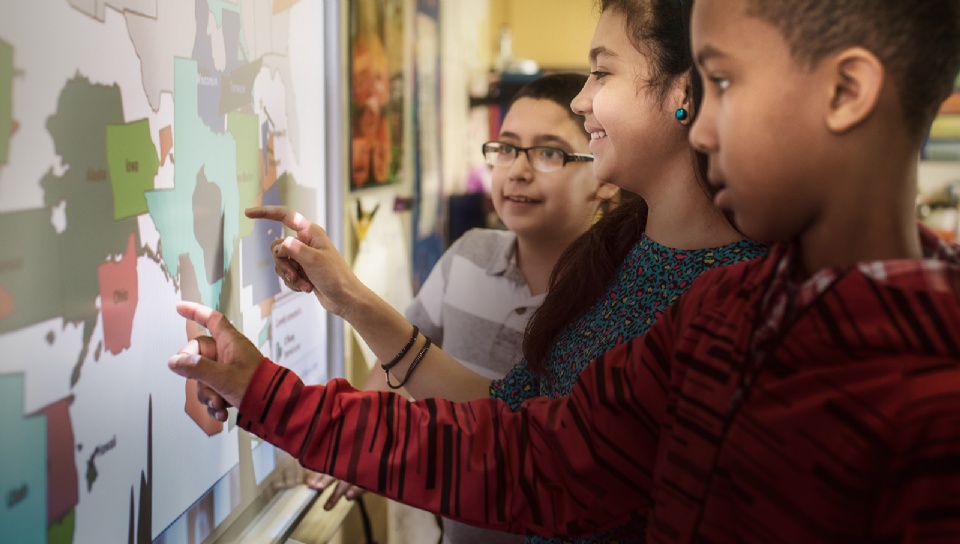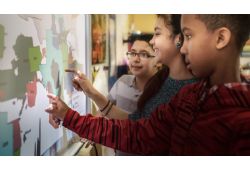The
Sir Wilfrid Laurier School Board has been purchasing interactive white boards
(commonly called SMARTboards) and training staff in their classroom use since
2006.
Due
to recent provincial allocations, the Sir Wilfrid Laurier School Board has
accelerated the process of installing interactive white boards in all of their
36 elementary and secondary schools. By the end of the provincial measure, 475 Interactive
white boards will have been mounted in nearly every SWLSB class and close to
1,000 teachers will have been trained in their use.
What
is an interactive white board?
Very
large, custom-made interactive white boards are extensively used by news
networks like CNN to animate such things as troop movements and weather
patterns.
In
education, an interactive white board resembles a classroom whiteboard
connected to a projector which, in turn, is connected to a computer. It sounds
simple enough, so why have the British and Australian governments committed to
place an interactive white board in every class, as well many Canadian and
American educational jurisdictions?
It’s
because of the touch. Under every interactive white board’s exterior, an array
of sensors waits to respond to every pressure and movement, making the board
truly interactive.
According
to Amanda Murdoch, a former teacher at Arundel Elementary School and current
Sir Wilfrid Laurier School Board consultant, an interactive white board in
class “is highly engaging and really makes a difference – everyone’s looking;
everyone’s listening; everyone’s on task.”
Pedagogical
experts maintain that a child’s learning is not limited to the written word. We
all learn in many ways, using our sight, hearing and touch. Interactive white
boards allow children to learn in ways which suits them best.
“As
teachers, we’re always trying to address the different learning styles of our
classrooms – auditory learners, visual learners and kinesthetic learners.”
continued Ms. Murdoch. “The interactive white board is an excellent tool
because it connects to all learners at once. Everyone wants to participate. No
one can really hide from the interactive white board. They’re really involved
in the learning process.”
Stephanie
Abbate, a St. Jude Elementary School teacher, agreed. “Not only are my lessons
more authentic with the interactive white board but I think they’re more
meaningful. I’m able to come up with more creative lessons… so much better. It
[the in-class Interactive white board] supports my lessons, supports my
teaching and, therefore, makes learning so much more meaningful.”
Eventually,
interactive white boards may even lower expenses in other areas.
Kristen
Sarrazin-Lalonde, a teacher at Grenville Elementary School, alluded to this
when commenting on the technological innovation.
“I
find the interactive white boards is excellent in helping me to teach,
especially the younger primary grades. They are a generation used to video
games and interactive [experiences] - being able to use an interactive white
board appeals to them. It allows them to work interactively with what they’re
trying to learn. An interactive white board is the best manipulative you can
find in a classroom.”
Educational
leaders stress that teaching and content must always direct the ways
technological devices are used in the classroom; however, classrooms must also
reflect their society. Students relate to technology; be it cell phones,
tablets, laptops… and interactive white boards.
The
inclusion of such devices can make students better learners and better citizens
of the 21st Century.

 In The Latest Issue:Latest Issue:
In The Latest Issue:Latest Issue:
- Celebrating Community an...
- Celebrating the Unsung H...
- Understanding Newborn St...
Articles
Calendar
Virtual- ANNUAL TEACHER APPRECIATION CONTEST
- APPUI LAVAL
- ARTS & CULTURE
- CAMPS
- CAR GUIDE
- CCIL
- CENTENNIAL ACADEMY
- CHARITY FUNDRAISING
- CITYTV
- COSMODÔME
- COMMUNITY CONNECTIONS
- COVER STORY
- DINA DIMITRATOS
- ÉCOLE SUPÉRIEURE DE BALLET DU QUÉBEC
- EDITORIALS
- ÉDUCALOI
- EDUCATION
- EMPLOYMENT & ENTREPRENEURSHIP
- FÊTE DE LA FAMILLE
- FÊTE DU QUARTIER SAINT-BRUNO
- FAMILIES
- FESTIVAL LAVAL LAUGHS
- FÊTE DE QUARTIER VAL-DES-BRISES
- FINANCES
- GLI CUMBARE
- GROUPE RENO-EXPERT
- HEALTH & WELL-BEING
- 30 MINUTE HIT
- ANXIETY
- CHILDREN`S HEALTH & WELLNESS
- CLOSE AID
- DENTAL WELLNESS
- EXTREME EVOLUTION SPORTS CENTRE
- FONDATION CITÉ DE LA SANTÉ
- GENERAL
- HEARING HEALTH
- MESSAGES FROM THE HEALTH AGENCY OF CANADA
- MENTAL HEALTH
- SEXUALITY
- SOCIAL INTEGRATION
- SPECIAL NEEDS
- TEENS
- THE NUTRITION CORNER
- THE NUTRITION CORNER - RECIPES
- VACATION DESTINATION
- WOMEN'S FITNESS
- WOMEN'S HEALTH
- HILTON MONTREAL/LAVAL
- HOME & GARDEN
- INTERNATIONAL WOMEN'S DAY
- JAGUAR LAVAL
- LAVAL À VÉLO
- LAVAL FAMILIES TV SHOW
- LAVAL FAMILIES MAGAZINE CARES
- LAVAL URBAN IN NATURE
- LE PARCOURS DES HÉROS
- LES PETITS GOURMETS DANS MA COUR
- LEON'S FURNITURE
- LEONARDO DA VINCI CENTRE
- LFM PREMIERES
- LIFE BALANCE
- M.P. PROFILE
- MISS EDGAR'S AND MISS CRAMP'S SCHOOL
- MISSING CHILDREN'S NETWORK
- NETFOLIE
- NORTH STAR ACADEMY LAVAL
- OUTFRONT MEDIA
- PASSION SOCCER
- PARC DE LA RIVIÈRE-DES-MILLE-ÎLES
- PÂTISSERIE ST-MARTIN
- PIZZERIA LÌOLÀ
- PLACE BELL
- PORTRAITS OF YOUR MNA'S
- ROCKET DE LAVAL
- SACRED HEART SCHOOL
- SCOTIA BANK
- SHERATON LAVAL HOTEL
- SOCIÉTÉ ALZHEIMER LAVAL
- STATION 55
- STL
- SUBARU DE LAVAL
- TECHNOLOGY
- TEDXLAVAL
- TODAY`S LAURENTIANS AND LANAUDIÈRE
- TODAY`S LAVAL
- WARNER MUSIC
- THIS ISSUE
- MOST RECENT
Magazine
Interactive white boards in SWLSB Schools
Articles ~e 105,7 Rythme FM 4 chemins Annual Teacher Appreciation Contest Appui Laval Arts & Culture Ballet Eddy Toussaint Camps THIS ISSUE MORE...
CONTESTS Enter our contests
CONTESTS Enter our contests
CALENDAR
Events & Activities
COMMUNITY Posts Events
PUBLICATIONS Our Magazine Family Resource Directory
LFM BUSINESS NETWORK Learn more
COUPONS Click to save!
COMMUNITY Posts Events
PUBLICATIONS Our Magazine Family Resource Directory
LFM BUSINESS NETWORK Learn more
COUPONS Click to save!
SUBSCRIPTIONS
Subscribe to the magazine
Un-Subscribe
E-NEWSLETTER Subscribe to our E-newsletter Un-Subscribe
WRITE FOR US Guidelines & Submissions
POLLS Vote today!
E-NEWSLETTER Subscribe to our E-newsletter Un-Subscribe
WRITE FOR US Guidelines & Submissions
POLLS Vote today!
ADVERTISERS
How to & Media guide
Pay your LFM invoice
SUGGESTIONS Reader's Survey Suggest a Listing
LFM About Us Our Mission Giving Back Contact Us
SUGGESTIONS Reader's Survey Suggest a Listing
LFM About Us Our Mission Giving Back Contact Us
 PICK-UP LOCATIONS
Get a copy of LFM!
PICK-UP LOCATIONS
Get a copy of LFM!
TERMS & CONDITIONS Privacy | Terms
ISSN (ONLINE) 2291-1677
ISSN (PRINT) 2291-1677
Website by ZENxDESIGN



 BY:
BY: 


Tweet
Share